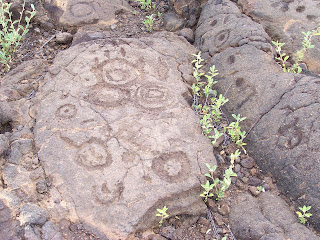
This field—over 15 acres—is covered with the stories of the people of old. It was a very hot day as I made my way down the rocky path, stopping every step or two to take another picture. The sun beat down on me and I was glad I had remembered to slather on sunscreen and to bring water. I had not remembered a hat-- much to my dismay—and later realized my scalp was sunburned. All in a day’s work…


Some of these symbols are similar to Puu’ola petroglyphs down at the bottom of Chain of Craters Road in that there are many circles and crescents with holes in the middle—piko holes--signifying the birth of a boy (circle) or a girl (crescent).

There were several lava tubes where the people hid when the kings were fighting—a place for the general population to get out of the way—women, children and elders headed for these caves. The men were drafted into the king’s army, and either came back victorious or not. The petroglyphs were thick, thick, thick around the entrance to the caves. Not one on top of the other—they seemed respectful of what had already been drawn there—but a whole scramble of images right next to each other.
 In one area the petroglyphs were surrounded by circles, as if to say “These pictures all belong together.”
In one area the petroglyphs were surrounded by circles, as if to say “These pictures all belong together.”
These simple faces never cease to interest me. I have seen similar faces in the bottom of Canyonlands National Park in Utah, at Bellows Falls, Vermont, and now in Hawaii. Have always wondered about their alien quality and their similarity….

There are parts of the gray lava that seem to have cooled so fast that the color of the heat stayed in them. This petroglyph was red underneath—very striking-- and the one next to it, not. It seemed to be a natural part of the stone and not something man-made.









